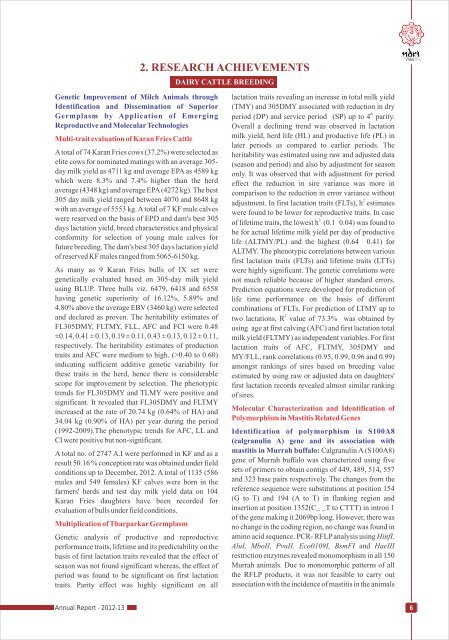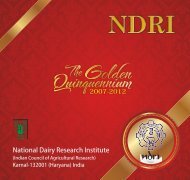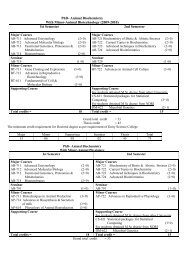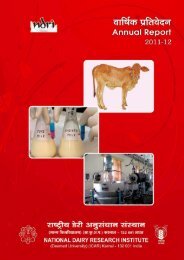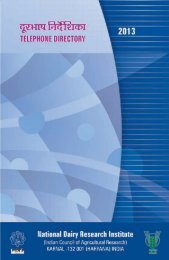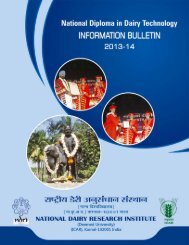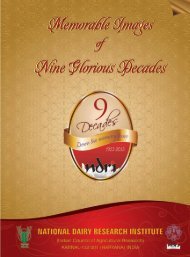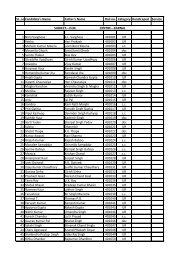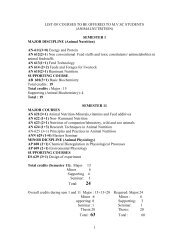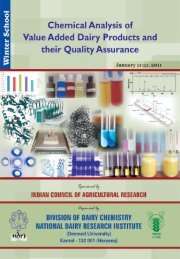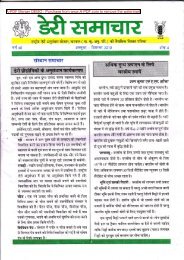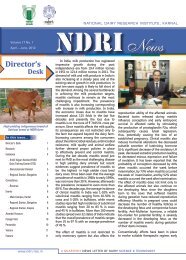executive summary - National Dairy Research Institute
executive summary - National Dairy Research Institute
executive summary - National Dairy Research Institute
You also want an ePaper? Increase the reach of your titles
YUMPU automatically turns print PDFs into web optimized ePapers that Google loves.
2. RESEARCH ACHIEVEMENTS<br />
DAIRY CATTLE BREEDING<br />
Genetic Improvement of Milch Animals through<br />
Identification and Dissemination of Superior<br />
Germplasm by Application of Emerging<br />
Reproductive and Molecular Technologies<br />
lactation traits revealing an increase in total milk yield<br />
(TMY) and 305DMY associated with reduction in dry<br />
th<br />
period (DP) and service period (SP) up to 4 parity.<br />
Overall a declining trend was observed in lactation<br />
Multi-trait evaluation of Karan Fries Cattle<br />
milk yield, herd life (HL) and productive life (PL) in<br />
later periods as compared to earlier periods. The<br />
A total of 74 Karan Fries cows (37.2%) were selected as heritability was estimated using raw and adjusted data<br />
elite cows for nominated matings with an average 305- (season and period) and also by adjustment for season<br />
day milk yield as 4711 kg and average EPA as 4589 kg only. It was observed that with adjustment for period<br />
which were 8.3% and 7.4% higher than the herd effect the reduction in sire variance was more in<br />
average (4348 kg) and average EPA (4272 kg). The best comparison to the reduction in error variance without<br />
305 day milk yield ranged between 4070 and 8648 kg<br />
2<br />
adjustment. In first lactation traits (FLTs), h estimates<br />
with an average of 5553 kg. A total of 7 KF male calves<br />
were found to be lower for reproductive traits. In case<br />
were reserved on the basis of EPD and dam's best 305 2<br />
of lifetime traits, the lowest h (0.1 0.04) was found to<br />
days lactation yield, breed characteristics and physical<br />
be for actual lifetime milk yield per day of productive<br />
conformity for selection of young male calves for<br />
life (ALTMY/PL) and the highest (0.64 0.41) for<br />
future breeding. The dam's best 305 days lactation yield<br />
ALTMY. The phenotypic correlations between various<br />
of reserved KF males ranged from 5065-6150 kg.<br />
first lactation traits (FLTs) and lifetime traits (LTTs)<br />
As many as 9 Karan Fries bulls of IX set were were highly significant. The genetic correlations were<br />
genetically evaluated based on 305-day milk yield not much reliable because of higher standard errors.<br />
using BLUP. Three bulls viz. 6479, 6418 and 6558 Prediction equations were developed for prediction of<br />
having genetic superiority of 16.12%, 5.89% and life time performance on the basis of different<br />
4.80% above the average EBV (3460 kg) were selected combinations of FLTs. For prediction of LTMY up to<br />
and declared as proven. The heritability estimates of<br />
2<br />
two lactations, R value of 73.3% was obtained by<br />
FL305DMY, FLTMY, FLL, AFC and FCI were 0.48 using age at first calving (AFC) and first lactation total<br />
±0.14, 0.41 ± 0.13, 0.19 ± 0.11, 0.43 ± 0.13, 0.12 ± 0.11, milk yield (FLTMY) as independent variables. For first<br />
respectively. The heritability estimates of production lactation traits of AFC, FLTMY, 305DMY and<br />
traits and AFC were medium to high. (>0.40 to 0.60) MY/FLL, rank correlations (0.95, 0.99, 0.96 and 0.99)<br />
indicating sufficient additive genetic variability for amongst rankings of sires based on breeding value<br />
these traits in the herd, hence there is considerable estimated by using raw or adjusted data on daughters'<br />
scope for improvement by selection. The phenotypic first lactation records revealed almost similar ranking<br />
trends for FL305DMY and TLMY were positive and of sires.<br />
significant. It revealed that FL305DMY and FLTMY<br />
increased at the rate of 20.74 kg (0.64% of HA) and<br />
Molecular Characterization and Identification of<br />
34.04 kg (0.90% of HA) per year during the period<br />
Polymorphism in Mastitis Related Genes<br />
(1992-2009).The phenotypic trends for AFC, LL and<br />
CI were positive but non-significant.<br />
Identification of polymorphism in S100A8<br />
(calgranulin A) gene and its association with<br />
A total no. of 2747 A.I were performed in KF and as a<br />
mastitis in Murrah buffalo: Calgranulin A (S100A8)<br />
result 50.16 % conception rate was obtained under field<br />
gene of Murrah buffalo was characterized using five<br />
conditions up to December, 2012. A total of 1135 (586 sets of primers to obtain contigs of 449, 489, 514, 557<br />
males and 549 females) KF calves were born in the and 323 base pairs respectively. The changes from the<br />
farmers' herds and test day milk yield data on 104 reference sequence were substitutions at position 154<br />
Karan Fries daughters have been recorded for (G to T) and 194 (A to T) in flanking region and<br />
evaluation of bulls under field conditions.<br />
insertion at position 1352(C_ _T to CTTT) in intron 1<br />
of the gene making it 2069bp long. However, there was<br />
Multiplication of Tharparkar Germplasm<br />
no change in the coding region, no change was found in<br />
Genetic analysis of productive and reproductive amino acid sequence. PCR- RFLP analysis using HinfI,<br />
performance traits, lifetime and its predictability on the AluI, MboII, PvuII, Eco0109I, BsmFI and HaeIII<br />
basis of first lactation traits revealed that the effect of restriction enzymes revealed monomorphism in all 150<br />
season was not found significant whereas, the effect of Murrah animals. Due to monomorphic patterns of all<br />
period was found to be significant on first lactation the RFLP products, it was not feasible to carry out<br />
traits. Parity effect was highly significant on all association with the incidence of mastitis in the animals<br />
Annual Report - 2012-13<br />
6


